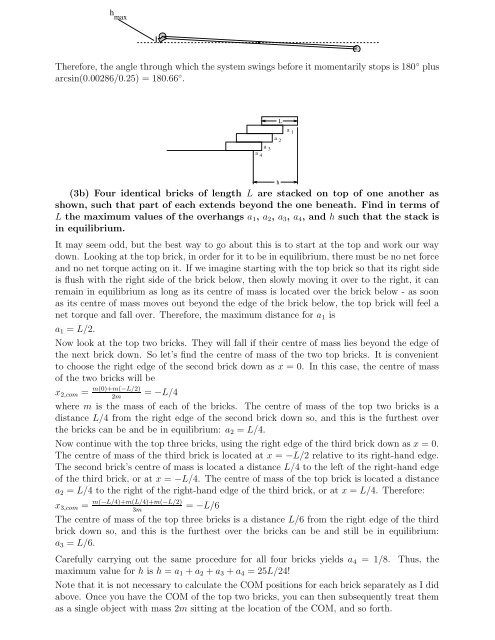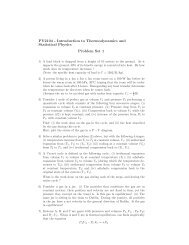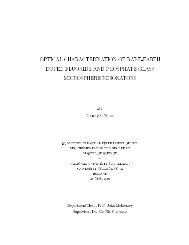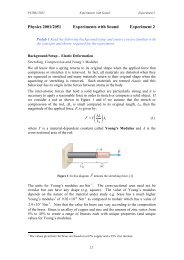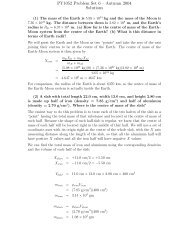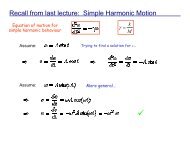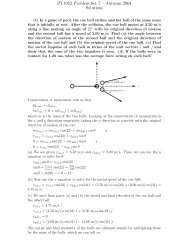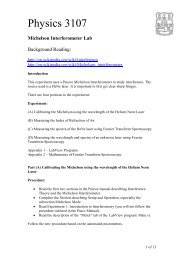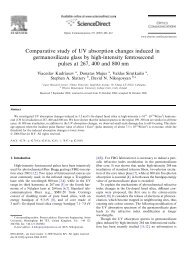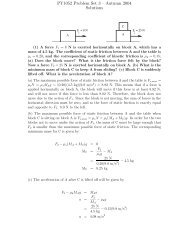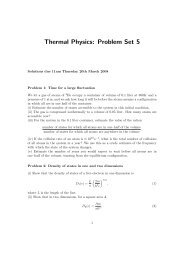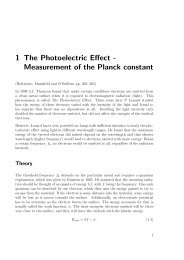PY1052 Problem Set 8 â Autumn 2004 Solutions
PY1052 Problem Set 8 â Autumn 2004 Solutions
PY1052 Problem Set 8 â Autumn 2004 Solutions
You also want an ePaper? Increase the reach of your titles
YUMPU automatically turns print PDFs into web optimized ePapers that Google loves.
©h max¡ ¡¡¡¡ ¡ ©Therefore, the angle through which the system swings before it momentarily stops is 180 ◦ plusarcsin(0.00286/0.25) = 180.66 ◦ .La 1a 2a 3a 4(3b) Four identical bricks of length L are stacked on top of one another asshown, such that part of each extends beyond the one beneath. Find in terms ofL the maximum values of the overhangs a 1 , a 2 , a 3 , a 4 , and h such that the stack isin equilibrium.It may seem odd, but the best way to go about this is to start at the top and work our waydown. Looking at the top brick, in order for it to be in equilibrium, there must be no net forceand no net torque acting on it. If we imagine starting with the top brick so that its right sideis flush with the right side of the brick below, then slowly moving it over to the right, it canremain in equilibrium as long as its centre of mass is located over the brick below - as soonas its centre of mass moves out beyond the edge of the brick below, the top brick will feel anet torque and fall over. Therefore, the maximum distance for a 1 isa 1 = L/2.Now look at the top two bricks. They will fall if their centre of mass lies beyond the edge ofthe next brick down. So let’s find the centre of mass of the two top bricks. It is convenientto choose the right edge of the second brick down as x = 0. In this case, the centre of massof the two bricks will bex 2,com = m(0)+m(−L/2) = −L/42mwhere m is the mass of each of the bricks. The centre of mass of the top two bricks is adistance L/4 from the right edge of the second brick down so, and this is the furthest overthe bricks can be and be in equilibrium: a 2 = L/4.Now continue with the top three bricks, using the right edge of the third brick down as x = 0.The centre of mass of the third brick is located at x = −L/2 relative to its right-hand edge.The second brick’s centre of mass is located a distance L/4 to the left of the right-hand edgeof the third brick, or at x = −L/4. The centre of mass of the top brick is located a distancea 2 = L/4 to the right of the right-hand edge of the third brick, or at x = L/4. Therefore:x 3,com = m(−L/4)+m(L/4)+m(−L/2) = −L/63mThe centre of mass of the top three bricks is a distance L/6 from the right edge of the thirdbrick down so, and this is the furthest over the bricks can be and still be in equilibrium:a 3 = L/6.Carefully carrying out the same procedure for all four bricks yields a 4 = 1/8. Thus, themaximum value for h is h = a 1 + a 2 + a 3 + a 4 = 25L/24!Note that it is not necessary to calculate the COM positions for each brick separately as I didabove. Once you have the COM of the top two bricks, you can then subsequently treat themas a single object with mass 2m sitting at the location of the COM, and so forth.h


